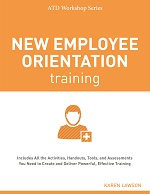ATD Blog
Your Mission: Design Effective Onboarding
Thu Nov 19 2015


Employees are an organization’s most valuable resource. Yet the way in which most organizations welcome a new employee creates the opposite impression. Bringing a new employee on board is a process, not an event. It involves providing information, training, mentoring, and coaching over a six- to 12-month period.
The importance of a successful onboarding program is underscored by the following research:
As many as 4 percent of new employees leave their new jobs after a disastrous first day.
New employees decide within the first 30 days whether they feel welcome in the organization.
One in 25 people leave a new job just because of a poor (or nonexistent) onboarding program.
Designing an Interactive Orientation Program
The first step in bringing a new employee into the organization is the formal orientation program. Many organizations approach this in a haphazard fashion. Others spend thousands of dollars and a great deal of time and effort on slick PowerPoint presentations, multiple guest speakers, and voluminous employee handbooks. Yet the new employee walks away from the session dazed, anxious, and overwhelmed. Why? What’s more, how can we design better programs?
Involve the new employees. For starters, the typical new employee orientation program is boring. Like many other training programs, it is presenter-centered and lecture-drive, with little or no opportunity for participant interaction. This traditional approach is characterized by too many facts, figures, and faces packed into a few hours. Then, when the new employee finally gets to his or her work site, it’s obvious no one is prepared for his or her arrival.
Be memorable. The orientation program is really the employee’s first exposure to the organization; therefore, it should be an enjoyable and memorable experience. Because it sets the tone, the new employee orientation program needs to be a priority. A thoughtfully planned and delivered program helps the employee transition, creates positive feelings about the organization, and ignites the employee’s excitement and enthusiasm.
Cover the intangibles. Organizations that “skimp” on orientation programs not only short-change the employee, they miss the perfect opportunity to communicate and help the employee to embrace and internalize the organization’s philosophy, values, norms, and culture. Employees also need to understand how they fit into the big picture, that what they do is important and makes a difference. Thus it can help the new employee become more comfortable, confident, and competent.
Bottom line: When designing a new employee onboarding program remember the learning objectives:
Help the new employee internalize organizational values, norms, and culture.
Help the new employee integrate into the organization and to begin to build relationships.
Help the new employee understand how they fit into the “Big Picture.”
For more tips on how to design an effective onboarding program, check out New Employee Orientation Training (ATD Press, November 2015).
